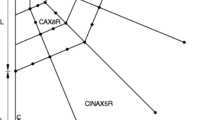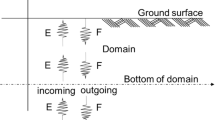Abstract
After a brief review of studies on artificial boundaries in dynamic soil-structure interaction, a three-dimensional viscous-spring artificial boundary (VSAB) in the time domain is developed in this paper. First, the 3D VSAB equations in the normal and tangential directions are derived based on the elastic wave motion theory. Secondly, a numerical simulation technique of wave motion equations along with the VSAB condition in the time domain is studied. Finally, numerical examples of some classical elastic wave motion problems are presented and the results are compared with the associated theoretical solutions, demonstrating that high precision and adequate stability can be achieved by using the proposed 3D VSAB. The proposed 3D VSAB can be conveniently incorporated in the general finite element program, which is commonly used to study dynamic soil-structure interaction problems.
Similar content being viewed by others
References
Aki K and Richards PG (1980), Quantitative Seismology Theory and Methods I, Freeman and Company, WH.
Chen SL and Liao ZP (2003), “Multi-transmitting Formula for Attenuating Waves,” Acta seismologica sinica, 16(3): 283–291.
Deeks AJ and Randolph MF (1994), “Axisymmetric Time-domain Transmitting Boundaries,” Journal of Engineering Mechanics, ASCE, 120(1): 25–42.
Foreman MG (1986), “An Accuracy Analysis of Boundary Conditions for the Forced Shallow Water Equations,” Journal of Computational Physics, 64: 334–367.
Higdon RL (1986), “Absorbing Boundary Conditions for Difference Approximations to the Multi-dimensional Wave Equation,” Mathematics of Computation, 47: 437–459.
Jing LP and Liao ZP(2000), “Combination of Local and Global Artificial Boundary Condition,” Earthquake Engineering and Engineering Vibration, 20(3): 8–14. (in Chinese)
Kausel E (1988), “Local Transmitting Boundaries,” Journal of Engineering Mechanics, ASCE, 114(6): 1011–1027.
Keys RG (1985), “Absorbing Boundary Conditions for Acoustic Media,” Geophysics, 50: 892–902.
Liao ZP (1996), “Extrapolation Nonreflecting Boundary Conditions,” Wave Motion, 24: 117–138.
Liao ZP (1997), “Numerical Simulation of Near-field Wave Motion,” Advances in Mechanics, 27(2): 193–212.
Liao ZP (2002), Introduction to Wave Motion Theories in Engineering, China Academic Press, Beijing. (in Chinese)
Liu JB and Lu YD (1997), “A Direct Method for Analysis of Dynamic Soil-structure Interaction Based on Interface Idea,” Zhang CH and Wolf JP ed, Dynamic Soil-Structure Interaction, International Academic Publishers, 258–273.
Liu JB and Lu YD (1998), “A Direct Method for Analysis of Dynamic Soil-structure Interaction,” China Civil Engineering Journal, 31(3): 55–64. (in Chinese)
Liu JB, Wang ZY and Zhang KF (2002), “3D Finite Element Analysis of Large Dynamic Machine Foundation Considering Soil-structure Interaction,” Engineering Mechanics, 19(3): 34–38. (in Chinese)
Lysmer J and Kulemeyer RL (1969), “Finite Dynamic Model for Infinite Media,” Journal of Engineering Mechanics, ASCE, 95: 759–877.
Pekeris CL (1955), Proceedings of the national academy of sciences USA, 41: 469.
Smith WD (1974), “A Nonreflecting Plane Boundary for Wave Propagation Problems,” Journal of Computational Physics, 15(4): 492–503.
The National Standard GB50267-97 (1998), “Code for Seismic Design of Nuclear Power Plants,” China Building Industry Press, Beijing. (in Chinese)
Underwood P and Green TL (1981), “Doubly Asymptotic Boundary-element Analysis of Dynamic Soil-structure Interaction,” International Journal of Solids and Structures, 17: 687–697.
Wang ZY (2002), “Computational Theory of Dynamic Response of Large Structure-soil Systems and Its Application,” Dissertation for PhD. Tsinghua University, Beijing. (in Chinese)
Wolf JP (1986), “A Comparison of Time-domain Transmitting Boundaries,” Earthquake Engineering and Structural Dynamics, 14: 655–673.
Wolf JP (1988), Soil-structure-interaction Analysis in Time Domain, Prentice-Hall, Englewood Cliffs, NJ.
Wolf JP and Paronesso A (1992), “Lumped-parameter Model for Rigid Cylindrical Foundation Embedded in Soil Layer on Rigid Rock,” Earthquake Engineering and Structural Dynamics, 21: 1132–1144.
Wolf JP and Song CM (1995), “Doubly Asymptotic Multi-directional Transmitting Boundary for Dynamic Unbounded Media-structure Interaction Analysis,” Earthquake Engineering and Structural Dynamics, 24: 175–188.
Xu ZL (1990), Elasticity Mechanics, Higher Education Press, Beijing. (in Chinese)
Yan JY, Jin F, Xu YJ et al. (2003), “A Seismic Free Field Input Model for FE-SBFE Coupling in Time Domain”, Earthquake Engineeing and Engineering Vibration, 2(1):51–58
Zhao CB, Zhang CH and Zhang GD (1989), “Analysis of 3D Foundation Wave Problems by Mapped Dynamic Infinite Elements,” Science in China Series A, 32(4): 479–491.
Author information
Authors and Affiliations
Corresponding author
Additional information
Supported by: National Natural Science Foundation of China Under Grant No. 50478014; Special Funds for Major State Basic Research Project Under Grant No.2002CB412706; Research Funds from National Civil Defense Office of China for the Tenth Five-year Plan
Rights and permissions
About this article
Cite this article
Liu, J., Du, Y., Du, X. et al. 3D viscous-spring artificial boundary in time domain. Earthq. Engin. Engin. Vib. 5, 93–102 (2006). https://doi.org/10.1007/s11803-006-0585-2
Received:
Accepted:
Issue Date:
DOI: https://doi.org/10.1007/s11803-006-0585-2




